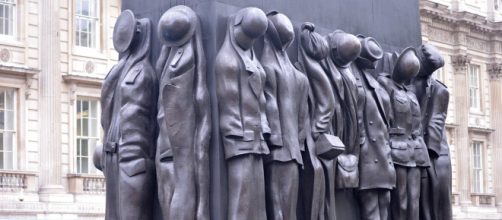The Associated Press reports that when Dwight D. Eisenhower ordered the U.S. army to find and return the millions of artworks that Nazis seized from Jewish homes, the "Monuments Men" included women.
As the AP tells it, “women entered the picture after the war, when the focus turned to restitution.” That may sound like a second act, but it turned out to be the main act.
Restitution meant not only finding out where the Nazis hid the works, but also identifying the rightful owners. As I see it, that was the whole ballgame.
You might have picked up the female connection in the 2014 movie “The Monuments Men” with Cate Blanchett playing Rose Valland, a curator at the Jeu de Paume Museum in Paris.
The Nazis didn’t know Valland understood German and was privy to their conversations. She kept secret record of their meetings about their discussions of the artworks and who had owned them.
All of which is to say that the “Monuments Men” would never have retrieved a single painting or sculpture without intel from Valland. Neither would they have known the rightful owners.
As Blanchett explained to the press, Valland’s work “singlehandedly saved crate-loads, castle-loads full of works of art that otherwise could have easily been destroyed. The fact that she was working alone was an act of extraordinary bravery.”
Female complaint
Yet, instead of highlighting this part of the story, the movie – written, directed and produced by George Clooney – suffered a typic Hollywood flourish – a made-up romance.
Valland was shown tempting Clooney, who was the lead character in the movie. After turning over her records to him, she offered him cognac with an invitation to stay the night. He declined. In effect, making his character virtuous and Valland wanton.
(A note about the art pictured accompanying this column titled “Monument to the Women of World War II” by John W.
Mills, located at Whitehall, London).
Mills’ looks to be as disregarding of heroic women as does Clooney’s depiction of Valland. Rather than paying homage to the nearly seven million service and civilian women during World War II, he rendered them like wardrobe items hanging on clothes hooks.
For the record
To have the record straight, it’s a good thing Valland wrote a book about her efforts – “Rose Valland: Resistance at the Museum” published in 2013.
What’s more, the Monuments Men and Women Foundation will publish Valland’s memoir “The Art Front,” originally published in French in 1961.
Having stayed the Nazis from stealing Europe’s art treasures, she should have been written into Clooney’s script in a more reverential way.
Clooney has been quoted saying that his film is 80 percent true. Not even getting the 80 percent straight, you have to wonder what the remaining 20 percent was about.
Art historian Nigel Pollard at the UK’s Swansea University, faulted the movie for lack of historical accuracy: “There’s a kernel of history there, but ‘The Monuments Men’ plays fast and loose with it.”
That silly scene of attempted seduction, by itself, makes the case.


